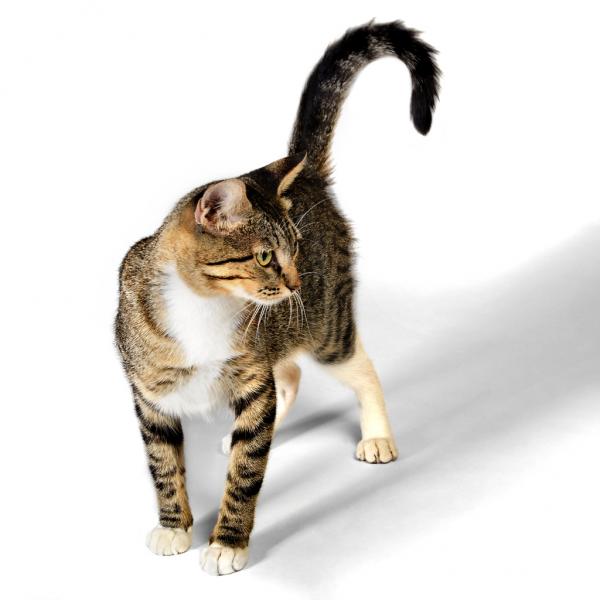Because cats wag their tails?

Cats move their hairy tail practically all day. At the same time, they are very communicative animals. These two facts are closely related to each other. The movement of the tail tells us many more things than we believe and know. Hidden in the butt of our cat, a whole conversation could be happening.
Because cats wag their tails? This action is not a simple physical spasm. There are dozens of speeches that can be interpreted from the movement of the tail of a cat, which are very varied, some obvious and others more subtle.
As we know our cat’s language beyond the meows, we know more about its personality and understand its nature. That’s why in this new article we want to tell you that there is not one, not two, many reasons Why do cats move their tails? and we will all explore them below.
The versatile tail of the cat
Thanks to how mobile it is, a cat’s tail is one of the most communicative parts of its body. If you pay attention to the behavior of your cat’s tail, you will see that there are a lot of different types of tail movements: it can be lifted up, down, diagonally stretched, raised with the tip bent down, movements fast or soft, rolled around yours or of themselves, stuck between the legs, bristling completely, among other things. Clear! Because it can be so complex that we are not only talking about movements as such, but also about the way the hair is put: flat, bristly or bristle-like type.
Basically the tail of a cat moves because he has something to tell us. Whether it is a wish, a state of mind or a warning, your cat expresses its inner world through this appendix. Most of these movements are voluntary, however, some studies indicate that others are involuntary.
Let’s see some basic trends:

The positive tail
- Up, trembling: A cat that shakes its tail, is a cat that is very excited to see you. They are good nerves, and this is a positive gesture. This can happen when you return home after a long day at work.
- Pointing up: It is a moment for kindness and tranquility. Notice that if you have a good relationship with your cat, he will choose to perform this gesture when he is around you. It is also a way to greet you in a cheerful way. Among cats it happens that when there is a mother with her puppies, she will raise her tail in this way, when she seeks to follow her or to get her attention.
- Tail lying forward on his back: This gesture can be somewhat strange but it indicates that your cat is really happy and happy with your presence. At the animal level, cats see us as their equals. This is his way of inviting us to smell his anal glands and to be friendly.

The intrigued tail
- Raised at an angle: This does not mean any threat to you or to your surroundings. The cat may be a little unsure about a possible new situation. Usually, it happens when you meet a new feline friend or someone who comes home for the first time. Observe that he performs this movement at the same time he sniffs this new subject.
- Tail lifted, with a hook at the tip: As if it were a feline question mark. This means that he has a conciliatory but reserved attitude, and not that he is not sure of something.
- Sweeping the tail: This is one of the most complex gestures because it could mean a series of things. Here you should be aware of the other types of body language of your cat to know exactly how it feels (ears, body, etc). Sweep the tail from side to side erratically, could mean things like: intense interest and attention to something (a toy, a prey) ecstasy for body grooming, frustration and anger if the tail hits the ground, an invitation to another friend cat to play.

The negative tail
- Hook at the base of the tail: When the hook is inverted or called “horseshoe tail” it is a gesture that indicates that the cat is in a defensive situation and open to aggression. Usually, the tail will also be bristled and the back arched.
- Tail lifted and shaken: This is a sign that the drama is coming from there. This type of tail usually transmits an emotion charged with intensity. It can indicate an ironic attitude in your cat and at the same time it tells you that it is angry for something and prefers to be alone. This he will do while passing by your side, without stopping, as if showing indifference.
- Brush tail: If your cat’s tail swells and its coat becomes thick and standing like the bristles of a brush, do not get too close. The feline feels threatened and is very likely to be aggressive. The same when it stays low and straight but with this time of hairs.
- Tail held between the legs: Your cat is afraid, is upset and even wants to stay alone. This a submissive tail but, at the same time, it is not good to neglect and lower your guard.

Cats do not just communicate by wagging their tails
Yes, you know Because cats wag their tails It is also important that you know that it is not the only way to communicate with their environment, but also use the ears, body position or head among other things to show their mood and give us to understand what happens. So it’s a matter of looking good, follow our instinct and empathize with our pussycat.
If you want to read more articles similar to Because cats wag their tails?, we recommend that you enter in our Curiosities section of the animal world.


